Here is an example of a fuchsia adequately supplied with all nutrients:
Leaves N% 3.2, P% 0.83, K% 5.3
Flowers N% 3.2, P% 0.55, K% 5.2
In the Andes wild fuchsia grown side by side with orchids.
You are using an out of date browser. It may not display this or other websites correctly.
You should upgrade or use an alternative browser.
You should upgrade or use an alternative browser.
Early K-lite results
- Thread starter dodidoki
- Start date

Help Support Slippertalk Orchid Forum:
This site may earn a commission from merchant affiliate
links, including eBay, Amazon, and others.
rcb
Well-Known Member
I've been using it year round and weekly, but at a low dose (1/4 tsp/gal).
There are lots of different extracts and concentrations, so may need to look at your particular brand for guidance.
I first used Maxigrow's last season used Kepak.
Just to continue the thinking process let's assume it is a phosphorous deficiency.
Why are you the only one seeing the deficiency?
After you ask your water company how they treat the water maybe we will have a clue.
How do you mix your fertilizer?
After mixing the fertilizer do you notice any undissolved solids in the bottom of the container? Any at all?
As for why only me? I don't know. Maybe I'm special, mom always told me that. :rollhappy: Or maybe because my conditions are extreme compared to most others? Or maybe others may be seeing a potential problem, but aren't willing to say so? I don't know the answer.
I mix my fertilizer by dissolving in 1 gallon warm water, then diluting to 20 l at a time. Yes I check for undissolved solids, actually every time. The warm water goes into a clear 1 gallon container, that I swish up, let set, then check for solids before adding to my sprayer, which is then filled to the 20 l with water. My background is polymer chemistry, but I do remember enough of inorganic chemistry to look for that. Not much else though.
http://www.conference.ifas.ufl.edu/intecol/presentations/125/0240 M Greenway.pdf
This is an interesting paper.
One difference is that the plants and media are kept wet all the time so that retained P can be accessed by the plant after retention.
But one slide in particular shows an impressive amount of long term phosphorus retention by the Al/Fe oxide clay ammendments.
There is even one slide that suggests competition between a plant and the ammendment system for P uptake.
I'm considering a scenario that:
1) Cutting K increased uptake of Ca/Mg with increased new growth/blooming with a higher P demand to keep up (compared to a K suppressed plants).
2) Higher P demand with less available in the fert, compounded by P adsorption in the potting mix got the plants to call up their reserves in old growth.
Adding some P back (as bone meal) could offset the P loss from the potting matrix, but you may consider adding some organic material to the matrix or semi hydro style watering systems.
I will eventually find out if adding back P helps. But it's going to take a while. I'm not ready to give up on K-lite completely. I have seen some positive benefits to it. I think I just need to find the right balance for my conditions.
rcb
Well-Known Member
Another question for rcb........
Do you have algae growing in your pots, on your pots or on your media or on the plant roots??
Yes, and btw, you can call me Renee. Not only do I, but I have noticed the moss growth has really taken off the last year. I mean really taken on, both on mounts and on top of LECA. I do have really high humidity, but still.....
I first used Maxigrow's last season used Kepak.
I mix my fertilizer by dissolving in 1 gallon warm water, then diluting to 20 l at a time. Yes I check for undissolved solids, actually every time. The warm water goes into a clear 1 gallon container, that I swish up, let set, then check for solids before adding to my sprayer, which is then filled to the 20 l with water. My background is polymer chemistry, but I do remember enough of inorganic chemistry to look for that. Not much else though.
OK. But you did not say if during the process there are any solids settled out that don't dissolve or may be a precipitate. Even a small deposit could account for a high amount of the "missing" Phosphorous.
Yes, and btw, you can call me Renee. Not only do I, but I have noticed the moss growth has really taken off the last year. I mean really taken on, both on mounts and on top of LECA. I do have really high humidity, but still.....
There is a very good chance the algae is consuming the Phosphorous.
rcb
Well-Known Member
"and as the plants came into bloom this past fall and winter I started to see the "issue"
Maybe a good reason to keep up the kelp year round.
My logic ?? on why only using kelp for part of the year - my wintertime conditions are not perfect, therefore I do not want new p'bulbs starting in fall/winter. Most of my plants are species, which theoretically should have somewhat defined growth/bloom/sometime rest stages. I thought giving them kelp year round could interrupt their natural stages.
I, of course, could be wrong in my thinking. But this was my reasoning for only supplying kelp in spring/early summer. Your thoughts?
One other thing to point out, my monopodials, which again theoretically grow year round? I'm not seeing problems with.
rcb
Well-Known Member
OK. But you did not say if during the process there are any solids settled out that don't dissolve or may be a precipitate. Even a small deposit could account for a high amount of the "missing" Phosphorous.
Sorry, No not solids settling in the bottom of the container that I mix my concentrate in. Could there be some suspended? Yes, but I have let my concentrate set for up to a day, and not see any solids settled.
Sorry, No not solids settling in the bottom of the container that I mix my concentrate in. Could there be some suspended? Yes, but I have let my concentrate set for up to a day, and not see any solids settled.
OK just want to make sure we can eliminate this as a loss of P.
Stone
Well-Known Member
There is a very good chance the algae is consuming the Phosphorous.
Now Lance....How much P could a bit of algae on top of a pot consume?
Now Lance....How much P could a bit of algae on top of a pot consume?
Perhaps a lot.
Chances are the roots are covered in algae as well a that "bit on top".
I think Algae is an important waste water management tool to remove Phosphorous from water.
On the other hand an increase in algae growth is an indication of high P levels.
So if Renee has plants showing signs of low Phosphorous and the algae is growing well one might think that the algae is eating the P before it reaches the plant roots.
OR
If the algae is growing well that is a sign that the the media and fertilizer have plenty of Phosphorous and Renee's problem is not a shortage of P.
Now Lance....How much P could a bit of algae on top of a pot consume?
Algae is 89.5% Phosphorous.
How many grams of algae is in one pot?
How much algae can one gallon of K-lite feed?
Algae will grab the P before the orchid roots have a chance.
Rick
Well-Known Member
Yes, and btw, you can call me Renee. Not only do I, but I have noticed the moss growth has really taken off the last year. I mean really taken on, both on mounts and on top of LECA. I do have really high humidity, but still.....
Renee
I generally find the presence of moss growth a positive indicator with orchids too.
Stone
Well-Known Member
Lets see..........If you dry it..... I would say 0.0000000000000000000000000000000000000000000000000000000000000000000000000000000000000000000000000000000000000000000000000000000000000000000000000000000000000000000000000000000000000000000000000000000000000000000000000000000000000000000000000000000000000000000000000000000000000000000000000000000000000000000000000000000000000000000000000000000000000000000000000000000000000000000000000000000000000000000000000000000000000000000000000000000000000000000000000000000000000000000000000000000000000000000000000000000000000000000000000000000000000000000000000000000000000000000000000000000000000000000000000000000000002 gms?:How many grams of algae is in one pot?
Lets see..........If you dry it..... I would say 0.0000000000000000000000000000000000000000000000000000000000000000000000000000000000000000000000000000000000000000000000000000000000000000000000000000000000000000000000000000000000000000000000000000000000000000000000000000000000000000000000000000000000000000000000000000000000000000000000000000000000000000000000000000000000000000000000000000000000000000000000000000000000000000000000000000000000000000000000000000000000000000000000000000000000000000000000000000000000000000000000000000000000000000000000000000000000000000000000000000000000000000000000000000000000000000000000000000000000000000000000000000000000002 gms?:
Renee has more than you.
Rick
Well-Known Member
Most of my plants are species, which theoretically should have somewhat defined growth/bloom/sometime rest stages. I thought giving them kelp year round could interrupt their natural stages.
I, of course, could be wrong in my thinking. But this was my reasoning for only supplying kelp in spring/early summer. Your thoughts?
One other thing to point out, my monopodials, which again theoretically grow year round? I'm not seeing problems with.
About 99% of my plants are species too, although my collection is heavier in slippers, bulbos, and phalaes (only maybe a dozen Catts/Dendro/Epi total). I don't try to drive cycles via water and feeding, but let the light/temp fluctuations do that. Granted I do reduce feeding/watering some in the winter since plant metabolism is generally slower with less light and heat. So no point in burying the plant in a lot of chemical it can't use.
I use Seaplex kelp extract. The percentage of cytokinins/auxin is only a percent or so, but the amount of other usable organics (for things like chelating metals) and backup Ca/Mg and micros is pretty decent. It even has a bit of K in it too. The recommended hydroponic feeding rate is 7-10ml/gal that can be reapplied once a week. I'm only feeding 1ml/gal. So I doubt I'm really hormonally pushing plants into odd seasons by this light dose of kelp. Anyway they appear to be putting up growths and flowers the same time each year regardless.
My monopodials (slippers and phalaes) have fast, slow, and bloom seasons too. So I don't think that is a legitimate distinction. I think a better way to look at this is CAM versus C3 metabolism (which is still not strict categories since some species can switch depending on environmental conditions at the time. But a big chunk of CAM orchids are Catts, which imparts drought resistance through mechanisms besides just opening pores at night. Leaf drop is also a means of saving water, and avoiding sun damage.
Are you also seeing an increase in root production? You are using a media that is pretty bad on holding water, and you may have been worried about root rot issues/restricting water. I have noticed that since reducing K, not only can I water more without root rot, but the more I water the more the plants/roots grow. (even shoe leather Catts are 85-90% water).
Stone (down in Australia) was having a very hot summer (this past winter for us) and remarked that he's been setting his plants in trays of water (HERESY!!), and counter to worries of root rot, is getting massive growth.
So maybe this still all just goes back to water consumption rather than nutrient deprivation.
speaking of algae, I just heard on the radio today that there is a kind of algae that has pigment spots that act just like eyes... just when you think you've heard everything!
Rick
Well-Known Member
speaking of algae, I just heard on the radio today that there is a kind of algae that has pigment spots that act just like eyes... just when you think you've heard everything!
I work with algae that crawl, glide, wiggle, and squirm. It's crazy:wink:
How are we supposed to kill algae if it's looking at us?
rcb
Well-Known Member
Are you also seeing an increase in root production? You are using a media that is pretty bad on holding water, and you may have been worried about root rot issues/restricting water. I have noticed that since reducing K, not only can I water more without root rot, but the more I water the more the plants/roots grow. (even shoe leather Catts are 85-90% water).
Stone (down in Australia) was having a very hot summer (this past winter for us) and remarked that he's been setting his plants in trays of water (HERESY!!), and counter to worries of root rot, is getting massive growth.
So maybe this still all just goes back to water consumption rather than nutrient deprivation.
I have not noticed a difference in root production since switching from MSU to K-lite. But it would be hard, as root production here is simply pretty crazy. When the sun comes up, and I go to get pics, I'll snap one of an average root area on my Catts as well.
As for water comsumption being the "cause" I don't ever like to say something isn't possible, but I do think it's unlikely. My potted plants get watered quite often, ie in summer 5 - 6 times a week. This is one of the many reasons I have switched to inorganic media. Less watering of course in the wintertime. But they do have dew almost every morning in the winter in addition to the waterings Mother Nature and I give them. If it was lack of water availability, I would think I'd see other symptoms as well.
And waterings haven't changed since I switched fertilizers.
rcb
Well-Known Member
Got the pics this morning.
This plant is Caulaelia Mizoguchi, currently in bloom with 3 spikes. Total 7 p'bulbs, 3 blooming, 3 loosing leaves, and one previously bloomed p'bulb so far staying green. None of these 7 p'bubs are more than 3 years old.
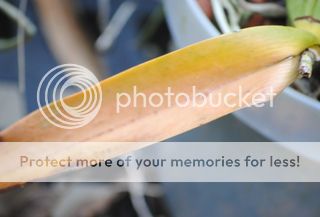
This is Guarianthe aurian.... don't make me spell it This is one of those exceptions it is not currently in bloom. (Mine bloom later here) A lot of p'bulbs, maybe 30+, of which in the past month, at least 10 have done this. You can see a clearly defined line, I want to comment, there is no shade/sun line on this leaf to cause that.
This is one of those exceptions it is not currently in bloom. (Mine bloom later here) A lot of p'bulbs, maybe 30+, of which in the past month, at least 10 have done this. You can see a clearly defined line, I want to comment, there is no shade/sun line on this leaf to cause that.
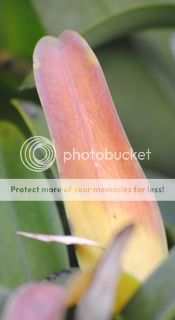
Now these next two are Hoyas which are also epiphytes, and which I am also seeing leaf issues with. They get the exact same treatment as the orchids. I show these because its a good comparison. This is not light related. These two are very closely related species, growing beside each other. The first on is in LECA, the second one is still in an organic media. Same watering, same light, same temps, same fertilizing rate and frequency.
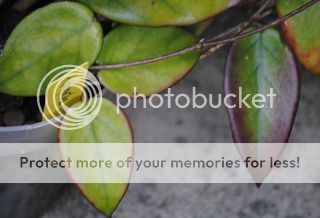

And two root photos, two different plants that I choose to try and show the average out there. The first one, it's been about three years in it's current pot, the second one was repotted last summer.
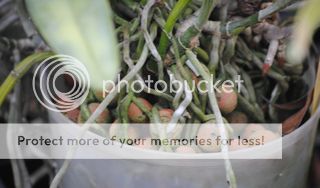
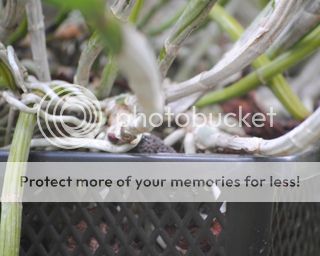
This plant is Caulaelia Mizoguchi, currently in bloom with 3 spikes. Total 7 p'bulbs, 3 blooming, 3 loosing leaves, and one previously bloomed p'bulb so far staying green. None of these 7 p'bubs are more than 3 years old.

This is Guarianthe aurian.... don't make me spell it

Now these next two are Hoyas which are also epiphytes, and which I am also seeing leaf issues with. They get the exact same treatment as the orchids. I show these because its a good comparison. This is not light related. These two are very closely related species, growing beside each other. The first on is in LECA, the second one is still in an organic media. Same watering, same light, same temps, same fertilizing rate and frequency.


And two root photos, two different plants that I choose to try and show the average out there. The first one, it's been about three years in it's current pot, the second one was repotted last summer.


Similar threads
- Replies
- 12
- Views
- 2K
- Replies
- 5
- Views
- 3K


